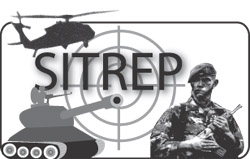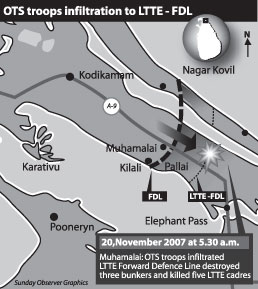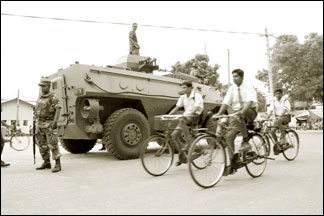Military in a dilemma

Protecting the territory under the Security Forces control in the
Jaffna peninsula is a challenging one. They have to throw a cordon
around two fronts in their endeavour one to provide a better security
network for more than 40,000 Security Forces personnel and the other for
the nearly a 500,000 civilian population in the peninsula.
They have to tackle both external and internal threats in their
attempts to ensure a better security situation in the peninsula and at
the same time confronting various allegations levelled against them
locally and internationally.
A land which was marred with violence, instigated by the LTTE,
challenging the
 Government rule there in the peninsula is now fast
returning to normalcy giving a glimpse of hope for a peaceful day today,
and life for nearly a 500,000 civilian population in the peninsula. Government rule there in the peninsula is now fast
returning to normalcy giving a glimpse of hope for a peaceful day today,
and life for nearly a 500,000 civilian population in the peninsula.
The LTTE's aborted attempt to capture the peninsula in a 72 hour
military operation launched on August 09, 2006 was the turning point in
the security situation in Jaffna.
Despite the bleak picture given to the outside world by interested
parties and certain media organisations working in collusion with the
agenda of the LTTE, a completely different situation prevail now in the
peninsula.
The methodology which the troops adopted to secure the FDLs in Jaffna
has undergone a complete change after the LTTE's attempt to capture
Jaffna peninsula on August 11, 2006. The Tiger infiltration into Jaffna
has come down drastically with the adoption of new methodology to defend
the FDLs thus preventing Tiger infiltration into the cleared areas.
The military operation launched on November 07, was also a part of
this exercise by the troops attached to the FDLs in Kilali, Muhamalai
and Nager Kovil.
The troops manning the defences are now reaping the benefits out of
the increased security measures following their surprise attack on the
first Defence line of the LTTE in Muhamalai and Kilali on November 06.
|

Jaffna students pedal past an armoured car as military keep a
close eye. Pic: Rukmal Gamage |
They laugh at the media report published in the South giving a wrong
impression about their operation without understanding the ground
reality in the FDLs in Jaffna.
"It was a well planned operation after gathering information on the
Tiger positions ahead of our defences for months and we had a clear idea
what we had to do", Lt. Chanaka Ratnayake, a platoon commander of the
first battalion of the Vijayaba Regiment, who participated in this
operation told this columnist.
Even after this military operation, the troops are still engaged in
the process of neutralising Tiger threats on the Security Forces
operating ahead of their FDLs killing at least five to 10 cadres on a
single day.
During the last two days the troops killed at least 16 Tiger cadres
in six confrontations along the Muhamalai FDL.
On Friday troops at the Kilali defence lines, retaliated a small arm
and mortar fire by the LTTE around 11.45 a.m. killing at least 2-3 LTTE
cadres. One soldier was critically injured in the incident and was taken
to Palali Base Hospital. Later, the soldier succumbed to his injuries.
Separately in the same area, army snipers shot two LTTE cadres who
had been stalking towards the Security Forces' FDL on the same morning.
At Muhamalai FDL, four LTTE cadres were killed in two separate
clashes broke out on Friday morning between 9.45 a.m. to 10.45 a.m. when
troops detected and attacked at a group of terrorists ahead of the FDL.
Two LTTE cadres were killed in this incident.
|

Ambassader Anthony Bailey and Her Royal Highness Marie Therese
Hohenberg with Defence Secretary Gotabhaya Rajapaksa. |
The second incident took place in the same area troops confronted
were with group of LTTE cadres who had stormed at the Security Forces
FDL. Troops repulsed the attack effectively and killing two LTTE cadres
and injuring two others. On Thursday troops deployed in the Muhamalai
FDL opened fire at a group of four LTTE cadres try to infiltrate
Security Forces' defences around 10 in the morning. Troops confirmed
that two LTTE cadres were killed and the other two were injured in the
incident. One soldier sustained injuries due to terrorists' return fire.
Troops manning the defences in Kilali launched yet another
pre-emptive strike at the LTTE defence line around 12.15 p.m. on
Thursday. At least six LTTE cadres were killed in the incident.
Earlier on Thursday, troops deployed at Muhamalai Front attacked the
LTTE defence line and destroyed five bunkers and a 60mm mortar location
and capturing the mortar launcher. Six terrorists were killed and one
soldier sustained injuries in the incident that took place around 2 a.m.
These small group operations have become a part of the lives of the
troops manning the defences in Muhamalai, Nager Kovil and Kilali sectors
which come under 55 Division of the Sri Lanka Army under the command of
Brigadier Kamal Gunaratne.
"These small group operations have become a part of our soldiers and
the military operation launched on November 6 was a part of the overall
military strategy of the Security Forces for the FDLs in Jaffna",
Brigadier Kamal Gunaratne added.
Troops can now easily capture the first line of the LTTE which is
located 500 metres away from the Security Forces FDLs in Muhamalai as
Tiger cadres very rarely move into this line, in fear of attacks from
the Security Forces. Even this columnist reached the Muhamalai and
Kilali FDLs from which troops broke out to launch a surprise attack on
the LTTE first line on November 6. There is no fear of a direct fire
from the LTTE since there is no Tiger cadres presence there in the first
line of the LTTE.
"The threat is coming in the form of indirect fire from the LTTE
using mortar and artillery", Brigadier Kamal Gunaratne, General Officer
Commanding 55 Division of the Sri Lanka Army added.
Through these tactics troops have been able to fully engage the LTTE
without allowing them to reorganise themselves to launch a major attack
on the Security Forces.
Considering the importance of this month, during which the LTTE
celebrates the birthday of the Tiger leader Velupillai Prabhakaran
unleashing violence against the Security Forces, the Forces have reached
much success by neutralising any Tiger attempt to launch attacks in
their bid to capture Jaffna.
Not only external threats, the looming internal threats have also to
be effectively tackled by the Security Forces in Jaffna to maintain law
and order in the peninsula. The 51 Division under the command of the Lt.
B. R. Mark is fulfilling huge task to effectively neutralize the Tiger
threat internally.
Since the troops under the command of the 51 Division have to face
this challenge while moving with a civilian population, their task has
become more sensitive one.
According to intelligence reports the Tiger leadership has deployed a
large number of intelligence cadres in the peninsula along with their
families to destabilize the situation as they have no opportunity to
influence public meetings and protests against the Security Forces.
Therefore, the Security Forces and the Police have been compelled to
screen each and every civilian in the peninsula so as to nab these LTTE
elements among the general public.
The detection of an armoury which had more than 600 Kg of C4
explosives from a house in Achchuveli, in Jaffna on October 17 raised an
alarming situation about the internal security in Jaffna town.
According to Security Forces in Jaffna, Pedurupulle Jebanesan, the
owner of the house from which the Security Forces recovered this armoury
has surrendered to the Human Rights Commission in Jaffna prior to the
detection of this stock of explosives and a huge stock of arms and
ammunition.
Troops recovered 26 boxes each consist of 23 Kg of C4 explosive, one
box of T-56 ammunition, 16 boxes of bicycle balls, three boxes of bigger
sized bicycle balls, two boxes of bicycle balls used for claymore mines,
six bigger size suicide jackets, two small size suicide jackets, five
mobile phones, two mobile phone chargers, one GPS equipment, eight
detonators, two i-com sets, four antennas , one satellite phone, five 40
mm tomba bombs, two claymore mines, five remote control devices, T-56
silencer ammunition 790, driving licences, Army identity cards, field
dressings and 70 metres of code sheets.
Though the Security Forces made this recovery from his house there
was no chance for the Security Forces and the Police to question him for
further investigations since he is now in remand custody after
surrendering to the Human Rights Commission in Jaffna.
Amidst this situation the latest trend ruse adopted by the Tamil
youth surrendering to the Police through the Human Rights Commission (HRC)
office, Jaffna raised many doubts among the Security Forces and the
Police as they have many chances to evade arrest by the Security Forces
and the Police after engaging in violent activities against the Security
Forces and the Police.
After this incident the Security Forces and the Police are suspecting
whether these youth are surrendering genuinely due to life threats or
fearing arrests by the Security Forces who are now engaged in the task
of nabbing these LTTE elements inside the Government controlled areas in
the Jaffna peninsula.
According to statistics available with the Human Rights Commission
office in Jaffna, 122 people have so far surrendered to the Police
through their office in 2007.
However the trend has started exactly a year ago with 16 persons
surrendering to the Human Rights Commission office in November 2006 and
again another six persons surrendered in December 2006.
According to the officials at the HRC office in Jaffna many of the
civilians have surrendered to the HRC due to death threats and ransom
demands by unidentified groups.
They are taking the cover of the Regulations made by the President
under section 5 of the Public Security Ordinance (Chapter 40) published
under the Government Gazette Notification issued on September 12, 2006
to surrender to the Human Rights Commission as they can easily evade
Police investigations about their past records.
The Security Forces pointed out that another suspect who had demanded
ransom from lawyers in Jaffna acting as an Army personnel from the
Palali camp has also surrendered to the Chavakachcheri Magistrate
through a lawyer, when he came to know that he was going to be caught in
the Police net.
Sanagarasa Madialagan, a 25 year youth from Vanakudiruppu, Puloli
West has demanded ransom from many lawyers based in Jaffna, compelling
many of the lawyers to leave Jaffna. However, Security Forces and the
Police expedite the investigations and identified this person as he was
obtaining money from a bank.
There are many such examples to point out that many Tiger activists
are surrendering to the Human Rights Commission in fearing their arrest
by the Security Forces and the Police but none of them have admitted
that they have engaged in terror activities or were in possession of
explosives at the time they were surrendering to the Human Rights
Commission.
Majority of these youth surrendering to the Human Right Commission
has stated that they were surrendering due to death threats by
unidentified persons.
According to Prison Officials 180 persons surrendered to the Human
Rights Commission are now in remand prison after the Magistrate, put
them in remand custody after they were produced before the Courts by the
Police.
The Jaffna Prison which has a capacity to accommodate only 250
persons is now overflowing as 450 persons are now accommodated in the
prison, though it has no required facilities.
The Prison authorities are facing difficulties as they have to
accommodate these 180 surrendees along with other convicted criminals
inside the prison, since it has no adequate space to provide separate
cells for them.
But the Security Forces and the Police are now sensing something
regarding the surrendering of these youth as they feel more than 90 per
cent of them have a LTTE background and have engaged in terror
activities against the Security Forces and the Police under the
influence of the LTTE.
There is no possibility for the Police to conduct any investigation
into their past activities, with their surrender to the Police.
The Regulations under the Public Security Ordinance (Chapter 40) very
clearly indicate that Police can conduct investigations only three
months after they are assigned to the respective Rehabilitation Centre.
It seems many of these surrendees are exploiting the legal cover
provided to them for LTTE cadres to surrender to the Human Rights
Commission to its maximum to protect themselves from the Security Forces
and the Police.
The intelligence reports gathered by the Security Forces too have
already given an early warning to the Defence Authorities about the
possibilities of using this situation for the advantage of the LTTE.
Given the context at least 100 LTTE supporters who gather at one
place will help to break the cells in the Jaffna prison where no armed
personnel are deployed to guard them.
Even under these circumstances, a Rehabilitation Centre is
established to relocate these surrendees, there are chances for them to
organise themselves against the Security Forces.
The Police have already refused a request by the Judiciary to give
armed protection to the Rehabilitation Centre proposed to set up close
to Gurunagar in Jaffna using the old High Court building.
The proposal of setting up this Rehabilitation Centre at this
location has also come under criticism of the Security forces and the
Police in Jaffna since the proposed location is in a highly sensitive
area in Jaffna which can be easily accessed by the LTTE from Pooneryn
side through a beach landing.
Since the proposed building is located only 50 metres away from the
beach, it can be easily misused by the LTTE for reorganizing themselves
against the Security Forces. Many of the surrendees at the Jaffna prison
were well aware of this proposal and demanding they be sent to the new
location under the condition they be given similar facilities at the new
location too.
A number of surrendees interviewed by this columnist with the
approval of the prison authorities were of the opinion that they be
transferred to the new location since it would give provide enough room
for them to move freely.
Therefore, the possibilities cannot be ruled out that LTTE by means
of sending their agents to the prison influencing them towards this to
get the maximum advantage out of the legal redress given to these
civilians to re-organize them against the Security Forces.
Therefore, the Security Forces also have to face this internal threat
in their bid to protect the Jaffna peninsula from possible invasion by
the LTTE in the month of November as they have already countered many
attempts by the LTTE. |
